Knives are crucial tools for cooking, used by both world-famous chefs and everyday people, whether they’re preparing meals at home, cooking outdoors, preparing a meal for themselves, or making food for others.
Among the most popular knives used by chefs globally are German and Japanese styles. Each type excels in specific situations due to differences in style and function, leading to a preference for one over the other in certain cases.
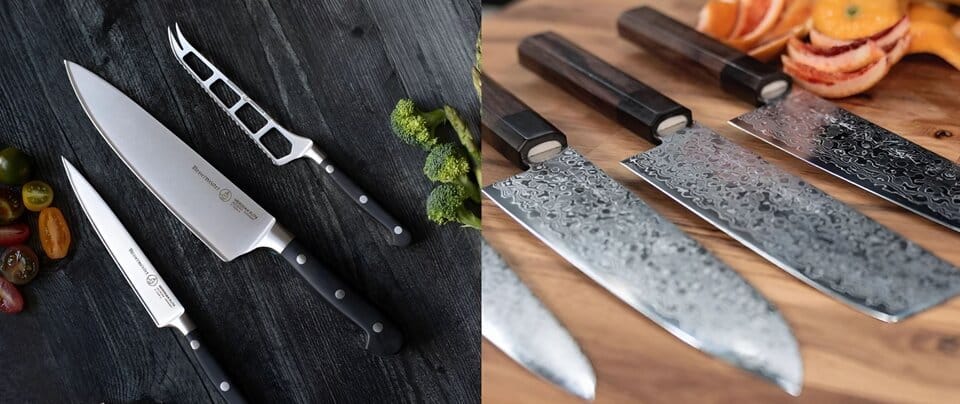
The blade is the metal part of the knife and the most important part. It’s crucial for knives from both Germany and Japan to have a full tang. This means the blade extends into the handle, unsharpened, providing stability, strength, and flexibility. This makes the knife versatile for various cutting tasks.
Material
The main difference between Japanese and German knives is the type of steel they are made from. Both are made from steel, which requires a right balance between flexibility and strength, similar to the various types of steel used for swords.
Japanese knives are made with harder steel, which allows them to keep a very sharp edge. However, this hard steel can also make them more likely to chip or get small damaged spots along the sharp edge.
On the other hand, German knife blades are made with softer steel, making them less prone to chipping or breaking over time. They contain less carbon, making the steel softer and more resistant to rust and corrosion. This also means they are easier to sharpen than Japanese blades. The downside is that they lose their sharpness faster and need to be sharpened more often.
Profile
The blade profile refers to the shape and design of the blade from the handle to the tip. This influences its cutting and chopping abilities and how the cutting edge interacts with what you are cutting.
The Japanese chef’s knife usually has a straight blade edge, which supports an up-and-down cutting motion. This blade profile is perfect for making clean cuts and slices, and it allows for precise cutting.
On the other hand, German Western-style blades have a more rounded profile. This shape is great for a smoother rocking motion when cutting. You can easily move from the blade’s tip to the handle and back, making precise slices with ease.
Thickness
The thickness of a blade involves both its internal texture and material, as well as its width and thickness. This greatly affects how the blade performs in cutting or slicing tasks.
Japanese steel making generally results in thinner blade profiles compared to German blades, thanks to its crafting methods. This leads to a very slim bevel, making the blade razor-sharp and easily sharpened for quick dicing. Japanese cooking knives also have a consistent thickness along their entire length, as most are made without a bolster.
German knives often have a bolster, which is where the steel blade meets the handle. At the bolster, the steel becomes wider, adding weight and balance. This design feature allows for a smoother transition from handle to blade, thanks to the style of craftsmanship.
Finish
The finish of a blade aims to achieve a specific level of smoothness on the surface, which affects how much friction there is when cutting and ultimately its durability. This makes slicing through various foods, whether a steak or a vegetable, easier or harder, depending on the blade’s finish.
German knives usually have a smooth finish that lowers friction and focuses on the blade angle. This helps the knife cut through food smoothly and efficiently.
Many Japanese knife brands feature a textured surface. For instance, the Shun classic Japanese utility knife displays a swirly Damascus pattern, and the Oiysha knife boasts a traditional hammered texture. These textures help reduce drag and prevent food from sticking to the blade, although the effect on performance is not significantly impacted.
Sharpness
Sharpness in quality knives mainly depends on their hardness, shown on the Rockwell scale (HRC) in the knife’s description, and more importantly the sharpened degree angle. Sharpness is crucial in knife making because it influences how well the blade cuts and how long it stays sharp.
Japanese knives are typically sharper than German ones due to their design, edge angle, bevel, and carbon content. Japanese-style knives are sharpened to an angle of about 9 to 16 degrees.
In contrast, German knives, with their thicker blades and lower high-carbon content, are sharpened to an angle of 14 to 20 degrees. While this might suggest Japanese knives are of higher quality because of their sharpness, a downside is that they have lower edge retention, meaning they dull faster and can be more easily damaged.
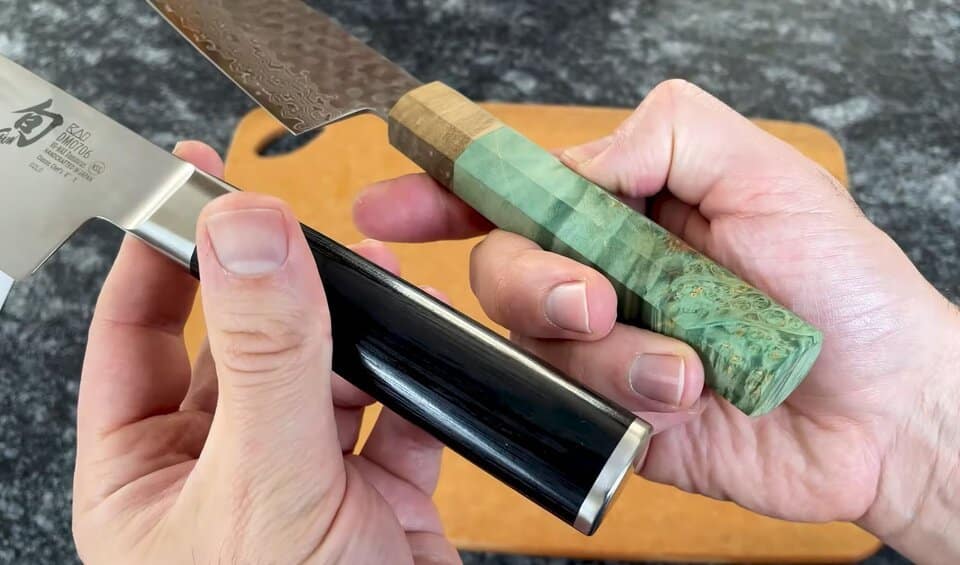
The handle is the part you hold while using the blade for chopping or cutting. It’s designed to make using the blade easier and more effective, improving the overall experience for the user.
Material
Traditional Japanese kitchen knives often have wooden handles, made from either hardwood or wood composite. This choice of material, along with their design, makes them visually appealing. For example, Shun knives feature Pakka Wood handles, known for being very lightweight.
These wooden handles are moisture-resistant and comfortable to hold, and they look great because of the polishing process they undergo. Some Japanese knives, like the Oysha knives, feature European-style handles made from materials like stabilized maple burr, which has been dried in a room for two years, making them extremely lightweight.
German knife handles are usually made from synthetic materials, such as polymers or polypropylene. Their construction and the materials used make them larger and heavier compared to Japanese knives. However, the size and weight can differ among various German brands.
Design
Japanese knife handles come in various designs, with oval, octagonal, and D-shaped being some of the most popular. German knives usually have ergonomic, symmetrical handles with flat sides along their length and a curve towards the end.
A significant difference is in the tang design. Traditional Japanese knives have a tang that tapers inside the handle, making the front of the knife heavier than the handle. This makes them lighter and more agile but less balanced.
German kitchen knives have a full tang that goes to the very end of the handle, often riveted and visible from both ends. This design provides more flexibility and balances the weight around the center of the knife.
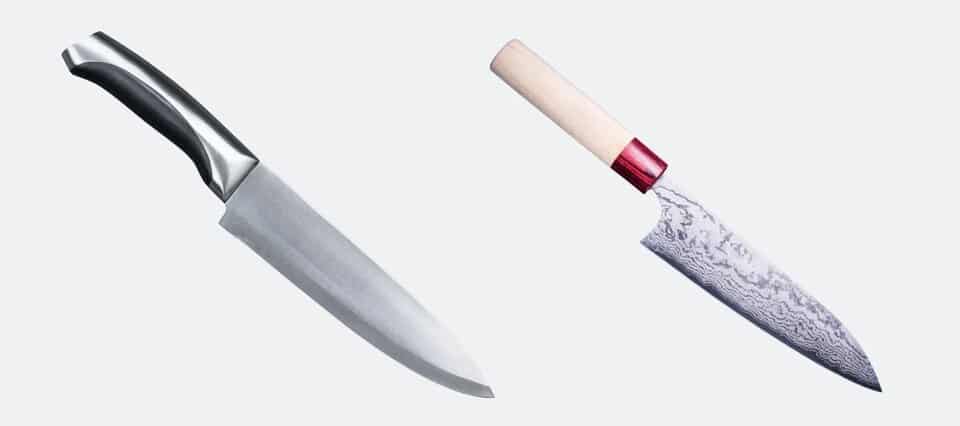
German knives are heavier than Japanese knives due to their thicker blades, full tang construction, and larger handles. This extra weight makes them effective at cutting through tough food items, making them suitable for home cooks and versatile enough for recipes from all over the world. They typically weigh around 9.4 ounces (266 grams).
Japanese knives, being lighter, are better suited for tasks that require precise cuts and are easier to control, as they don’t tire your wrist as much. They usually weigh about 5.8 ounces (160 grams).
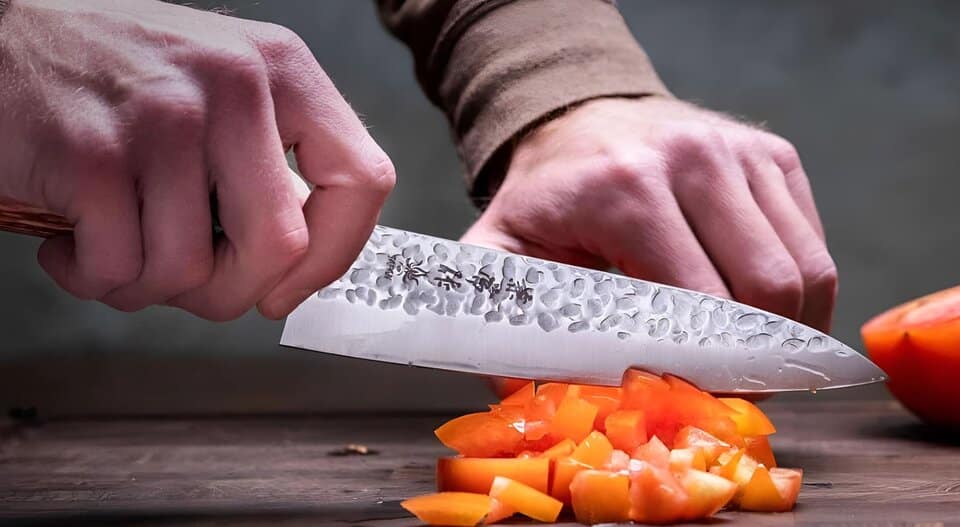
The cost of knives largely depends on the brand. Although prices vary, Japanese knives generally tend to be more expensive.
This often stems from their traditional craftsmanship, like using more layers in the blade construction, seen in Nakiri, Sashimi, or a Santoku knife. The craftsmanship includes traditional methods and materials, such as hagane or yasugi carbon steel, which feature inner and outer cores that differ in hardness and metal type.
German types of knives, which are also high-quality kitchen tools, tend to be more affordable, generally ranging from $80 to $180. In contrast, Japanese knives often start at $200 and can sometimes exceed $300.
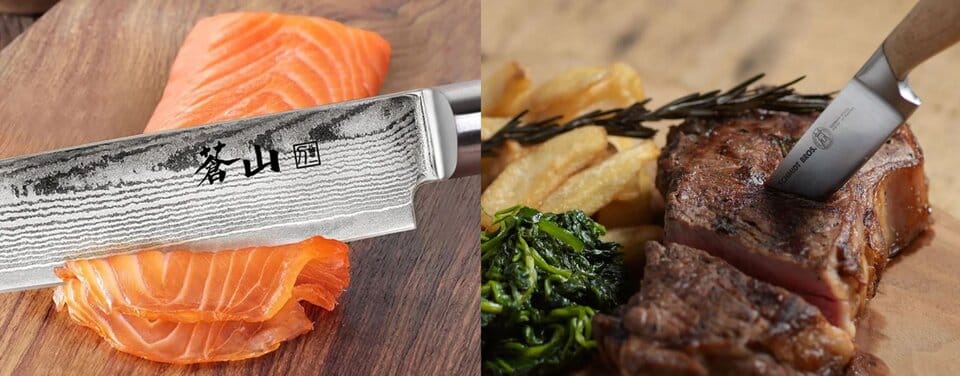
Japanese and German knives are both excellent choices for cooking, offering high versatility. However, they have differences that might make one more suitable than the other, depending on your cooking style.
Japanese knives are incredibly sharp and lightweight, perfect for traditional Japanese dishes that require precise cuts. German knives are known for their toughness and durability.
German knives are great as steak knives, bread knives, are heavier in design and ideal for preparing traditional European cuisine.
With the change and globalization of food items throughout the world, German knives and Japanese knives correspond in some sort of ways. For example, the German Wusthof keeps the traditional handle but takes traits of Japanese-style blades while a Japanese Mac knife has a Japanese blade but comes with a German-style handle.
The Women's Outdoor News, aka The WON, features news, reviews and stories about women who are shooting, hunting, fishing and actively engaging in outdoor adventure. This publication is for women, by women. View all posts by The WON